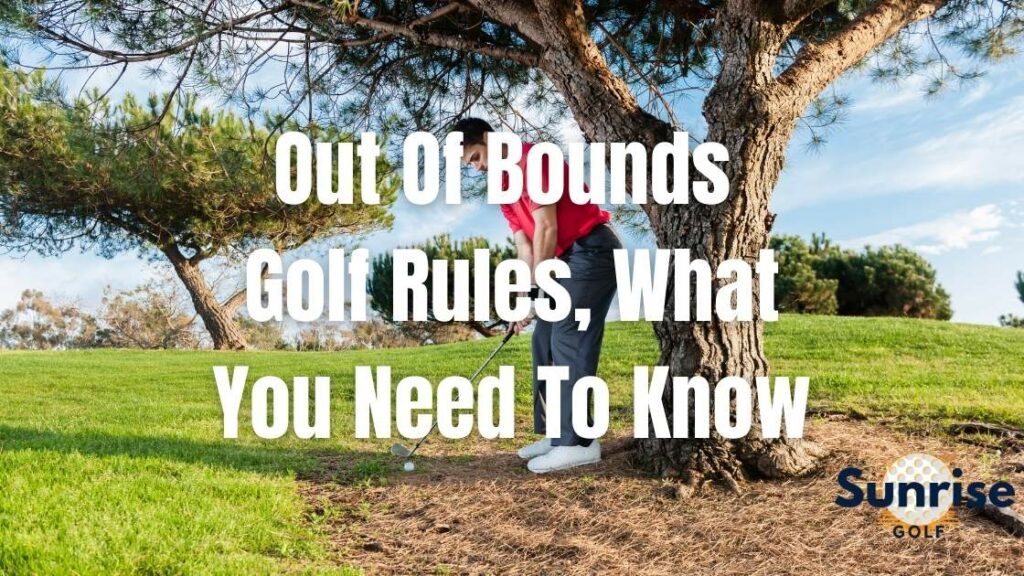Mastering the Rules of Golf: Understanding Out of Bounds
Golf is a game of precision and sometimes a slight miscalculation can send your ball sailing out of bounds (OB). It’s a situation no golfer wants to find themselves in, but knowing the rules can save you a few precious strokes on the course. So, let’s dive into the nitty-gritty of the out of bounds rule and how to navigate it.
Stroke and Distance Penalty:
When your ball decides to venture off the beaten path and lands out of bounds, you’re looking at a “stroke and distance” penalty. This means you’ll have to play your next shot from the exact spot where you played the previous one, and you’ll be adding one more stroke to your score. So, essentially, it’s a cost of two strokes. Tough luck, but hey, that’s golf!
Provisional Ball:
Now, if you suspect your ball might be lost or it might have gone out of bounds, you can play a provisional ball. This is a savvy move to save some time. Just make sure to declare it as provisional before you swing, so everyone’s on the same page.
Verifying Out of Bounds:
Once you’ve hit a shot and it’s veering dangerously close to OB territory, you have three minutes to search for it. If the search party comes up empty, your ball is considered lost and it’s back to the drawing board (or the previous spot) with you!
Defining Out of Bounds:
OB areas are usually marked by white stakes, lines, or even physical barriers like walls or fences. It’s always a good idea to check the back of the scorecard or have a chat with the local golf pro to understand the boundaries before you tee off.
Local Rules:
Each golf course might have its own nuances when it comes to the out of bounds rule. One such variation introduced recently allows for a much friendlier approach. If your ball goes out of bounds, instead of the traditional stroke and distance penalty, you have the option to drop a ball in the nearest fairway area with a two-stroke penalty.
This rule, aimed at speeding up the game and reducing frustration, is a godsend for recreational players. However, it’s not universally adopted, so it’s wise to check with the local pro or review the course rules before you tee off.
Ground Under Repair Relief:
Sometimes, the golf course has areas marked as ground under repair (GUR). If your ball lands in such areas, or even if it’s half on the fairway and half in a GUR, you’re in luck. The rules grant you free relief.
Here’s what you do:
- Identify the nearest point of complete relief, no closer to the hole.
- Use any of your clubs to measure one club-length from that point (you can use the longest club in your bag, excluding the putter).
- Drop your ball within this one club-length area, and you’re good to go!
It’s scenarios like these that showcase the fairness embedded in the rules of golf. So, the next time your ball cozies up to a GUR area, remember, you’ve got a fair way out!
Course Management Tips:
Playing it safe near OB areas is always a wise strategy. Opting for a club that you can control better or aiming away from trouble can save you a lot of heartache on the course. And remember, a smart golfer is a happy golfer!
With these insights on the out of bounds rule, you’re now better equipped to tackle any OB challenges that come your way on the golf course. So go ahead, swing with confidence, and may your balls always find the fairway!


When your golf ball is half on the fairway and ground under repair what you need to do play it or take a drop?
Hey Ian,
Thanks for your insightful question! When your golf ball finds itself straddling the fairway and an area marked as ground under repair (GUR), the rules of golf are on your side. You are entitled to free relief.
Simply find the nearest point of complete relief, no closer to the hole, and drop your ball within one club-length of that point.
This way, you’re not penalized for something out of your control like course maintenance. I’ll be sure to include this scenario in the article to help clarify the rules around ground under repair.
Appreciate your input!
Linda
What about new rule of bringing it out to the fairway?
Hey Max,
Great catch! You’re absolutely right. There’s a new local rule that allows players to drop a ball in the nearest fairway area with a two-stroke penalty when they hit it out of bounds, instead of having to replay the shot. It’s a fantastic rule to keep the game moving along nicely. I’ve updated the article to include this rule under the ‘Local Rules’ section. Thanks for bringing this to my attention!
Warm regards,
Linda
Some golf courses attempt to define out of bounds with describing out of bounds as a red penalty area to avoid a stroke and distance penalty of 2 strokes. This procedure is not a proper procedure and shows a disrespect to the spirit of playing this great game fairly!
Hey Jon,
Thanks a ton for chiming in! You’ve nailed a topic that gets golf purists and weekend warriors chatting over a 19th hole beverage. The classic out of bounds rule versus the more lenient red penalty area tagging by some courses—it’s a hot topic!
You’re spot on, the traditional rules are there to keep the game fair and square. There’s a sort of reverence to the game’s traditions that many hold dear, and for good reason.
On the flip side, some courses aim to sprinkle a bit of leniency to keep the vibes relaxed and inviting, especially for folks new to the greens. It’s like adding a dash of paprika to grandma’s classic recipe—some purists might raise an eyebrow, while others appreciate the modern twist.
Your insight’s a valuable addition to the discussion and really gets the golf balls rolling in our minds. Love the thought-provoking input, Jon. It’s comments like yours that add flavor to our golfing community!
Catch you on the fairway,
Linda